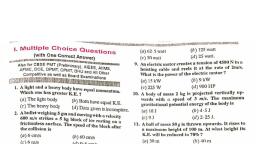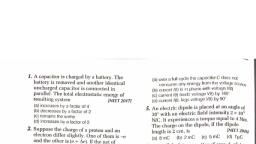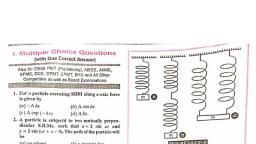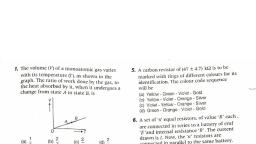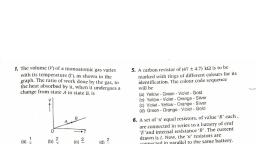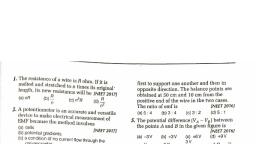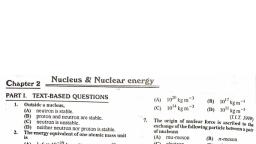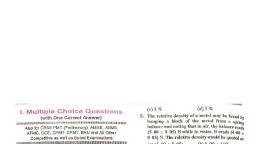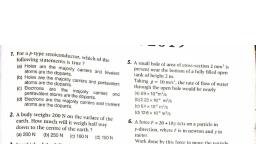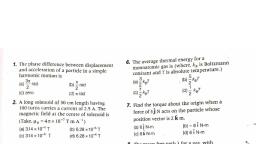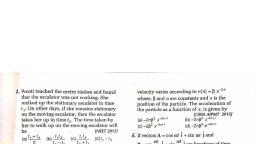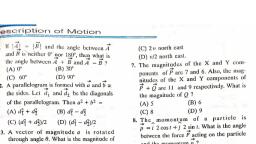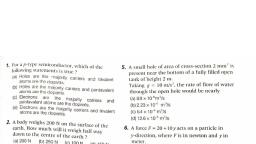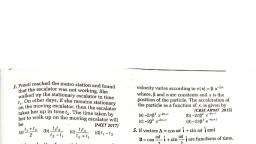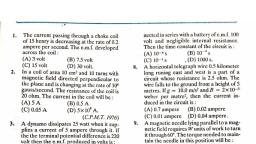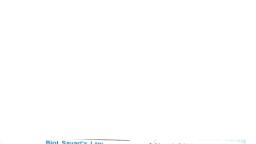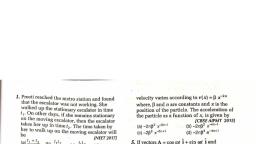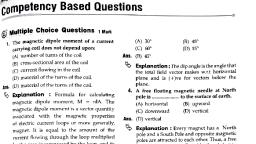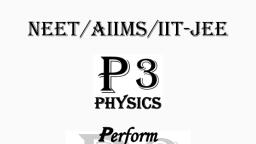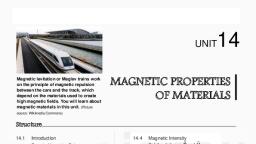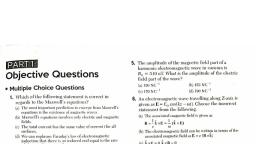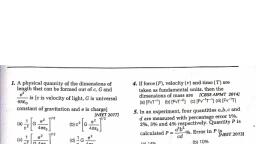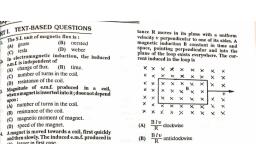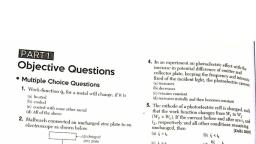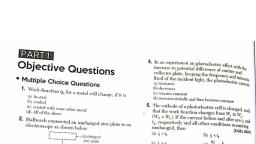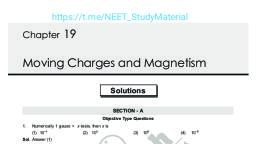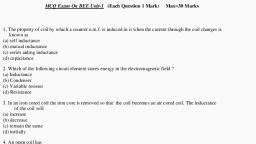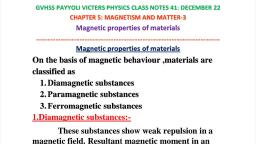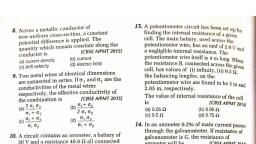Page 2 :
574, , », , 11,, , 12,, , 13., , 14,, , 15., , If the permanent Magnetic moment of the, , atoms of a substance ix zero, then substance Is, called ;, , (A) diamagnetic, (c) ferromagnetic, (D) antiferromagnetic, , (8) paramagnetic, , (C.P.M.T, 1993), The magnetic moment of atomic neon is equal, , lo:, (A) zero (B) py, (C) py/2 (D) 3yy/2, (N.C.E.R.T, 1984), Here, wy is Bohr magneton., The susceptibility of a diamagnetic substance, (A) decreases with temperature., (8) does not vary with temperature., (C) first decreases and then increases with increase of temperature., (D) increases with temperature., (Karnataka Entrance, 1994), The magnetic permeability is maximum for :, (A) paramagnetic (B) ferromagnetic, (C) diamagnetic (D) non-magnetic., Susceptibility is positive and small for a a, (A) paramagnetic (B) ferromagnetic, (C) non-magnetic — (D) diamagnetic., ' ‘ (C.P.M.T. 1990), Susceptibility is positive and large fora, (A) paramagnetic —_(B) ferromagnetic, (C) non-magnetic (1D) diamagnetic,, (C.P.M.T. 1990, 1982), If diamagnetic substance is brought near, north or south pole of a bar magnet, it is, (A) attracted by the poles., , (B) repelled by the poles., , (C) repelled by the north pole and attracted by, the south pole,, (D), , attracted by the north pole and re led, the south pole, - (CBSE £, , The relative permeability of a diamagnetic, material is, , {A) zero,, , (B) equal to unity,, (C) less than unity., , (D) more than unity,, , (A.R.M.C. 1998), If « diamagnetic solution is poured into a Utube and one arm of this U-tube placed between, , poles of a strong Magnet with the meniscus, , In a line with th field,, mecca © fleld, then the level of the, , (A) rise (B) fall, , (c) Oscillate slowly (D) remains as such., , 7” ' * (M.N.R 1993), : - Sere liquid contained inone ofthe, pret Fel a U-tube is held in an, , the meniscus in line with, the field, The li I, cates, the liquid et! S€€8 to rise. This indi, 16,, , 17., , 18., , 19., , 20., , 21,, , MODERN'S abc OF PHYS;, , CS (y, (A) ferromagnetic (1B) Heine, (C) diamagnetic (D) nonemes, , Manns, , Choose the correct answer ;, , (A) Diamagnetism occurs in ay, ‘, , (B) Diamagnetismis the resujt op, 28., ment of permanent magnetic Ton aly, , (C) ‘The magnetic field due tg indy Men, , neite moment is Opposite to ped, field. ote, , D) The magnetising ficld intens:, ) zero in free space, my i, , Which of following is not a unit f 7, magnetisation ? . imei, (A) Am"! (B) JT y-3, , () NT 'm? = @) art mt, Which of the following is not unit of, , induction ? Magnes, (A) T ®) Wom?, (C) JAg! m7?, , (D) Naty Which of the following relation is Not con, , (4) B=yo(1+H) (B) Bapy(1¢, () t=2=MeH gy y Q,, , a, 7, A uniform magnetic field (parallel to the piye, of the paper) existed in Space initially =, from left to right. When a bar of son iron, placed in the field Parallel to jt, the lines, , eee Passing through it, Will be represe, ly =, , , , , , , , , , , , , , , , , , , , , , , , , , , , , , , , , , , , HL! ee, Sind, = —, (8), (cy a, ch, (CPA, , At currie point, a ferromagnetic ma, , comes : ., (A) non-magnetic — (B) _diamagne!, (C) paramagnetic, , tic,, (D) _ strongly ferromagne Ww CERT., Above curie temperature, ferro™, Specimen : (A) remains ferromagnetic., (B) becomes ferromagnetic., , (C) becomes paramagnetic.
Page 3 :
om, , , , TTT Aee ry, , Ib Rane sevens ==, ) pecomes diamagnetic,, , (Karnataka, 1995, 1992), which of ~ following relation is not correct ?, , (A) %m, , B) Mo=Ho(l +%_)H, , (CE) Ho=H(+%,) (D) w= 14y, , for a magnetic material, the dependence, of the magpetic susceptibility y,, on the absolute temperature T is given by:, , w met (B) mq OT, , T, () Xm = é (D) x,, = constant, , A rod of a paramagnetic substance, such as, platinum is placed in a non-uniform strong, magnetic field. How will it align itself in the, , field:, , , , (ci (iO, , Arod of a diamagnetic substance, such as bismuth is placed in a non-uniform magnetic, field. How will it align itself in the field ? Refer, the four orientations as shown in last question., The hysteresis curve of a magnetic material is, generally studied for :, (A) diamagnetic materials., (B) ferromagnetic materials., (C) paramagnetic materials., (D) dielectric materials., , (Karnataka Entrance, 1991), Which of the following is most suitable for the, core of the electro-magnets ?, , Soft iron, , (A) Air (B), , (C) Stee! (D) Cu-Nialloy, (A.LLM.S. 1980), , Electromagnets are made of soft iron, because, , Soft iron has :, (A) low ibility and low retentivity., , (8) high susceptibility and low retentivity., (©) high susceptibility and high retentivity., , ©) low permeability and high retentivity., (MNN.R. 1988), , 3., , 32., , An electromagnet uses, (A) soft iron core (B) steel core, ick copper core, fe Per ee - EMC. 1988), ctromig, Soft iron is used to manufacture ele, , nets, because their = oN, , (A) magnetic saturation limit 1s high and, retentivity and coercivity are small., , (B), , retentivity is high., (C) coercivity is high., teresis loop is large., pees (NCERT.1980), Soft iron is used in many parts of electrical, machines for:, (A) low hysteresis loss and low permeability., (B) low hysteresis loss and high permeability., (C) high hysteresis loss and low permeability., (D) high hysteresis loss and high permeability., A magnetic needle suspended by a silk thread, , is vibrating in the earth's magnetic field. If the, temperature of the needle is increased by, , 500°C, then :, (A) the time period decreases., (B) the time period remains unchanged., , (C) the time period increases., (D) the needle stops vibrating. (M.N.R. 1994), , PART II. THOUGHT-BASED QUESTIONS, , 34., , Two particles, each of mass m and charge q, are, attached to the two ends of a light rigid rod of, length 2 R. The rod is rotated at constant angular speed about a perpendicular axis passing, through its centre. The ratio of the magnitudes, of the magnetic moment of the system and its, angular momentum about the centre of the rod, , is, , (A) (B) a, , 3/5 $|s, , q, ° (P) mi (ILLT. 1998), , A particle of charge q and mass m moves in a, cireular orbit of radius r with angular speed w., The ratio of the magnitude of its magnetic, moment to that of its angular momentum, depends on, , (A) wand¢ (B) «,qandm, (C) qandm (D) wandm, (LT. 2000), , The hysteresis cycle ft :, skeet can: for the material of per, (A) short and wide. (B) _ tall and narrow., (C) tall and wide., (D) short and narrow.
Page 4 :
37. The mass number of a nucleus is, [CBSE AIPMT 2003], , (a) sometimes equal to its atomic number, , (b) sometimes less than and sometimes more, than its atomic number, , (c) always less than its atomic number, , (d) always more than its atomic number, , 38. The volume occupied by an atom is greater, , than the volume of the nucleus by factor of, about [CBSE AIPMT 2003], , (ay10 = (by 10 ~=—() 10 (d) 10°, , 39. When a deuterium is bombarded on 0°, nucleus, an a-particle is emitted, then the, product nucleus is [CBSE AIPMT 2002], , (a) sie (b) 5B° (c) Be? (d) ia", , 40. Which of the following are suitable for the, fusion process ? [CBSE AIPMT 2002], , (a) Light nuclei, (b) Heavy nuclei, (c) Elements lying in the middle of periodic table, , (d) Elements lying in the middle of binding energy, cnive
Page 5 :
41. A forward biased diode is [CBSE AIPMT 2006), , (a) -4V -3V, ) 3V 5V, © -2V +2V, , ov -2V, , q@) ———~—a——, , 42. A transistor is operated in common emitter, configuration at constant collector voltage, V, =15V such that a change in the base, current from 100 1A to 150 pA produces a, change in the collector current from 5 mA, , to 10 mA. The current gain (B) is, [CBSE AIPMT 2006}, , (a) 67 (b) 75 (c) 100 (d) 50, , 43. A transistor-oscillator using a resonant, circuit with an inductor L (of negligible, resistance) and a capacitor C in series, produce oscillations of frequency f. If L is, doubled and C is changed to 4 C, the, , frequency will be [CBSE AIPMT 2006], f f f, , a) — (b) 8 f C). ae zs, , na i eB >, , 44. Copper has face-centered cubic (fcc) lattice, with interatomic spacing equal to 2.54 A., The value of lattice constant for this lattice, is [CBSE AIPMT 2005], (a) 1.27A (b)5.08A (c)2.54A (d)3.59A, , 45. Choose only false statement from the, , following [CBSE AIPMT 2005], , (a) Substances with energy gap of the order of, 10 eV are insulators, , (b) The conductivity of a semiconductor increases, with increases in temperature, , (c) In conductors the valence and conduction, bands may overlap, , (d) The resistivity of a semiconductor increases, with increase in temperature
